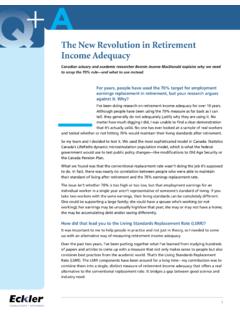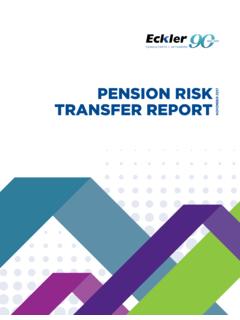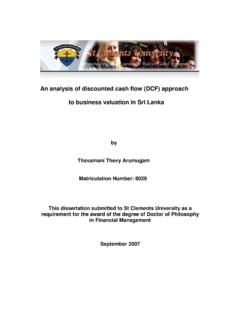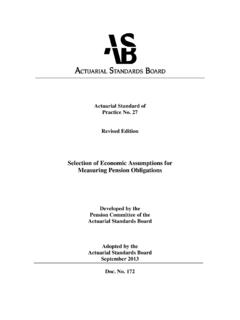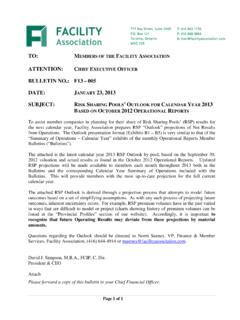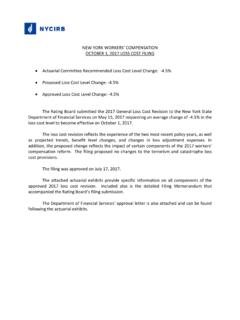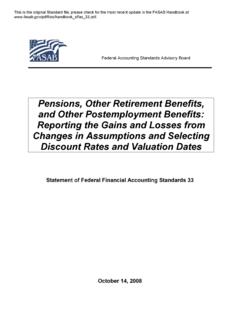Transcription of New Québec Legislation Proposes Major Changes …
1 Special Notice1 | A MEMBER OF ABELICA GLOBALNew Qu bec Legislation Proposes Major Changes to Pension Funding RulesJune 2015B ill 57: An Act to amend the Supplemental Pension Plans Act mainly with respect to the funding of defined benefit pension plans. Bill 57 was introduced on June 11, 2015, and is the product of a two-year consultation process stemming from the D Amours Report (Innovating for a Sustainable Retirement System). The bill introduces Major Changes to the funding rules for private sector defined benefit pension plans effective January 1, 2016, including: Eliminating solvency funding; Requiring that going concern funding be augmented by funding towards a stabilization provision, the amount of which will be specific to each plan s investment policy; and Changing the rules for use of surplus in ongoing plans and on bill also makes a number of Changes to the benefit provisions of the Supplemental Pension Plans Act (SPPA), including elimination of the additional pension benefit introduced in 2001, and rule Changes for commuted value payments when members elect bill should be subject to a parliamentary commission later this year.
2 The main features of the bill have been favourably received by various stakeholders, so it is not expected to change significantly before its January 1, 2016 effective Special Notice provides an overview of the funding and benefit Changes contained in Bill Notice2 | NEW QU BEC Legislation Proposes Major Changes TO PENSION FUNDING RULESF unding changesSolvency and Going Concern Funding While Bill 57 eliminates solvency funding, a plan s solvency must still be determined and used for specific purposes, such as the new limits on the use of surplus in an ongoing plan, funding rules for plan amendments, termination of a plan, filing frequency for actuarial valuations, and transfers of commuted values out of the plan (discussed below).
3 Effective January 1, 2016, plans must be funded on a going concern basis. Asset smoothing may still be used, with a maximum averaging period of five years. Letters of credit (LOCs) may be used for funding the new stabilization provision discussed below. Any LOCs may not be used to fund more than 15% of a plan s going concern liability, and the value of the LOCs must now be included in the plan s assets on a going concern basis (including existing LOCs at the time the measure becomes effective).The new funding rules require that technical and stabilization amortization payments be amortized over a 10-year period. However, for valuations prior to December 31, 2016, a 15-year amortization period may be used, which will be reduced gradually to 10 years by December 31, 2020.
4 In addition, transition rules provide that if the total annual employer contributions determined for the years 2016, 2017 or 2018 are greater than those that would have been payable in 2016 under the provisions in force on December 31, 2015, only one-third of the difference is payable in 2017 and the remaining two-thirds in 2018. Regular employer current service contributions are excluded from this transition ProvisionIn exchange for the elimination of solvency funding, plans must now fund an additional amount determined by a stabilization provision (essentially, a reserve account). The account will be funded through actuarial gains, current service contributions, and separate amortization payments. The target funding level for each plan will be based on a scale to be specified in forthcoming regulations.
5 It is expected that the funding level will vary depending on the plan s investment policy, with higher funding for plans with more aggressive policies. The current service stabilization contribution is payable until the plan reaches the stabilization provision amount plus 5%, while stabilization amortization payments will be paid until the plan reaches the stabilization provision amount minus 5%.Actuarial Valuations To prepare for the new funding regime, all plans must prepare an actuarial valuation as of December 31, 2015. For the purposes of this valuation, amortization payments required for previously established deficits are eliminated. Valuations will be done every three years, with an annual notice of the plan s financial position to be sent to the R gie des rentes du Qu bec within four months of the plan s fiscal year-end.
6 The upcoming regulations are expected to outline the content of this notice. If an annual notice indicates that a plan s solvency ratio is less than 85%, annual valuations will be contributions to fund the plan s deficit and to fund the stabilization provision are designated the employer s reserve and are subject to special monitoring. The value of this reserve will increase annually with interest calculated at the rate of return on plan assets, net of administration and investment fees. Any contribution holiday or surplus withdrawal by the employer will reduce the amount of the Notice3 | NEW QU BEC Legislation Proposes Major Changes TO PENSION FUNDING RULESUse of SurplusBill 57 Changes the rules governing the use of surplus in an ongoing plan and on termination.
7 It provides that surplus assets can only be used in an ongoing plan if: the plan is fully funded (on a going concern basis); the target funding level under the stabilization provision has been exceeded by 5%; and the plan s solvency ratio is at least 105%.Surplus assets in excess of the lesser of the above surplus amounts must first be used up to the employer s reserve to pay any employer current service contributions, irrespective of plan provisions. Any remaining excess surplus (up to 20% per year) must be dealt with in accordance with plan provisions, and can serve to pay for the costs of a plan amendment, or be returned to the employer, depending on plan 57 states that administrators must amend or confirm existing plan provisions on the appropriation and allocation of surplus assets in an ongoing plan or on termination.
8 The process requires that notices be sent to all plan members and beneficiaries, and the provisions are deemed to be confirmed if less than 30% of members file an objection. If no amendment or confirmation is made by January 1, 2017, the plan will be deemed to split surplus 50/50 between the employer and members on termination. The use of a portion of surplus by an employer in an ongoing plan will require that an equal portion be used to provide additional benefits to plan members and beneficiaries proportionately to the value of their benefits. Note that the use of the employer reserve to pay employer current service contributions on an ongoing basis is governed by Legislation and is not subject to the consultation process. As a result, new rules will apply to surplus distribution on plan termination, in lieu of the current surplus sharing proposal and arbitration rules.
9 As a result, new rules will apply to surplus distribution on plan termination, in lieu of the current surplus sharing proposal and arbitration Notice4 | NEW QU BEC Legislation Proposes Major Changes TO PENSION FUNDING RULESB enefit ChangesAdditional Pension BenefitThe requirement to fund the additional pension benefit introduced in 2001 will be eliminated. This benefit currently provides partial indexing of deferred pensions for former members until age 55. If the plan is amended on that point prior to January 1, 2017, the elimination may be retroactive to January 1, 2001 regardless of the rules for adverse amendments. PortabilityBill 57 provides that members who elect portability after termination will have their commuted value calculated based on the plan s solvency ratio, with no requirement to make up the shortfall.
10 Note that this provision will not apply in cases where terminating members are required by administrators to transfer their benefits that are below the small pension limits. Annuity PurchasesSimilar British Columbia s new Pension Benefits Standards Act, Bill 57 will amend the SPPA to provide that plans with an annuity purchasing policy meeting the requirements to be set out in regulations will be able to discharge their obligations to members following an annuity purchase. Unlike British Columbia, the SPPA will provide that affected individuals still have rights to share in any surplus if the plan is terminated within three years of the annuity ProvisionsBill 57 also contains the following notable provisions: Every plan must have a written funding policy, with content to be set out in regulations.
